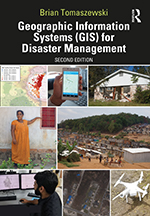
|
Chapter 2: Fundamentals of Geographic Information and Maps |
This is the companion website for Chapter 2: Fundamentals of Geographic Information and Maps from the book Geographic Information Systems (GIS) for Disaster Management (second edition). This page contains links to any technical video walk throughs contained in the chapters, slides for the chapters, chapter test questions, and other additional materials.
Chapter Abstract
The fundamentals of geographic information and maps for disaster management are discussed in this chapter as foundation for future chapters. Geographic information topics include maps scale, map projections, coordinate systems, and datums. Mapping topics focus on cartographic concepts that include data measurement for cartography (nominal, ordinal, interval, and ratio), visual variables, visual hierarchy, figure and ground relationships, and map types such as reference maps and thematic maps (choropleth, proportional symbol, isarithmic, and dot density). Map design concepts such as typography, labeling, common map elements (scale bar, legends, and inset maps), element positioning and balance are then discussed to provide guidance on creating effective, usable map products. The chapter concludes with a gallery of common examples of poorly made maps created with a GIS that can inform novice map makers. The chapter concludes with additional resources and a two hands-on exercises. The first is focused on the fundamentals of geographic information to understand the mechanics of how maps work as communication devices and to understand basic principles of geographic information as represented in maps. The second is a thematic map making for disaster management with commercial and open source GIS software to gain cartographic design and map creation experience.
Chapter Objectives: Upon chapter completion, readers should be able to:
- understand the difference between data and information;
- describe the concept of map scale and how map scale is represented;
- understand what map projections are and discern the differences between different map projection types;
- be familiar with common map coordinate systems;
- understand mapping principles such as data measurement, visual variables, and figure/ground relationships;
- discern the differences between reference and thematic maps;
- be familiar with common map design elements;
- identify common errors when first learning to use geographic information systems (GIS) to create maps.
Follow these links to access Chapter 2: Fundamentals of Geographic Information and Maps materials:
- Chapter 2 Slides (.pptx, 7.27 mb)
- Exercise 2-2: Basic Thematic Map-Making with GIS Software video walkthrough
- Chapter 2 Test Bank (.docx, 19 kb) | Chapter 2 Test Bank (.pdf, 158 kb)
For information on this chapter, purchase the book from Routledge Press »